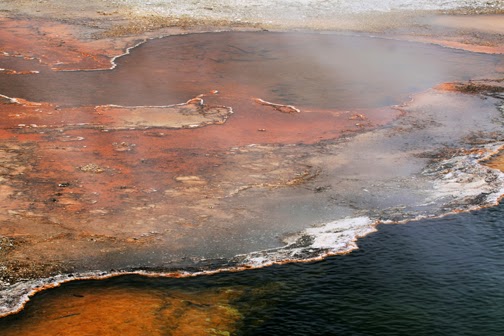.jpg) |
| Mammoth Hotsprings |
Imagine taking 10, 000 Mt. Saint Helen's, say 1,2,3 and now!
And they all blow up at the same time. Well, I am just playing with ideas since this is really, really difficult to imagine.
When it finally came to rest the landscape was changed forever. The super-volcano scarred the Earth with an enormous caldera of 70 x 55 km (or so), one of the largest in the world.
Then the Earth rested for another million years (actually 800 K) before another huge explosion rocked the region, piling hot lava on the top of an already high plateau created by that first explosion.
 |
| Beartooth Mountains - eastern part |
Another break and the last explosion (so far) followed some 700 thousand years after the second one .... and the Yellowstone Plateau was born. It is layered some 2,800 m high and covers close to 9,000 square km - as if that can be comprehended by a normal human being.
It is big!
 |
| Blacktail Deer Plateau east of Mammoth Hotsprings |
And it is still active, still burping somewhere not too deep below ("geologically" speaking of course).
All that activity left Yellowstone crisscrossed with underground tunnels and pools and narrow vents filled with rain and underground water, constantly superheated by magma.
 |
| Steam is escaping from the ground near Roaring Mountain |
 |
| Hot water rises from the depths, cools off in the air and falls back - creating bubbles |
 |
| Hot pool tinted by minerals - iron |
Or it squeezes through narrow vents mixing with gases and, all stinky, escapes constantly, hissing in disgust. Such features are labeled as fumaroles.
.jpg) |
| Fumaroles on Roaring Mountain |
At other times it shoots up in a spectacular show,
sometimes at regular intervals like the Old Faithful pictured below,
at other times building up their steam for years.
Geysers are not too common in the world and majority of them can be found in Yellowstone.
 |
| Old Faithful |
Geysers don't always shoot up into the air - sometimes they shoot up from the bottom
of Yellowstone Lake - forming cones near its surface.
The one below is named Big Cone.
 |
| Submerged geyser |
 |
| Mudpot |
There are also mud pools and paint pots - when there is not enough water to form a hotspring it just bubbles through the mud.
If all white or gray, it is a mud pool (mudpot).
When tinted by minerals it is a pain pot.
 |
| Paint Pot |
Not only is Yellowstone one of the largest volcanoes in the world, it is also the largest hydrothermal system on Earth.
Yellowstone is being carefully watched these days - not that if it ever decided to let another burp we, the people, could do much else but run. Rumbles of minor magnitudes occur frequently in Yellowstone, most of them hardly noticeable by our human senses. There are several hundreds, perhaps thousands of baby quakes there each and every year - the largest ones between 3 and 4 on the Richter scale.
And many rumbles are related to its lively and enormous hydrothermal system rather then the magma itself.
 |
| On the way from Norris to Mammoth Hotsptings |
 |
| On the way from Norris to Mammoth Hotsptings |
(If the Earth is round how can it have corners?).
The brave, snow-loving people can come during the winters too.
 |
| Wikipedia |
One such man was
(September 7, 1829 – December 22, 1887)
He managed to make sure that those who could sign the proper papers did so, thus creating a very first First National Park on the planet.
Rightfully one of the amazing valleys in the region had been named after him. - Hayden Valley in the eastern part of the park.
It is a beautiful and extremely rich ecosystem deserving a day or two of our time.
 |
| Hayden Valley |
There are so many other features in this amazing park - rivers, mountains, wildlife -
All that we need is time.
Time and money for gas.
 |
| Madison River Valley |
 |
| Madison River Valley |
No comments:
Post a Comment